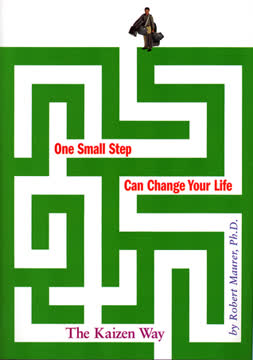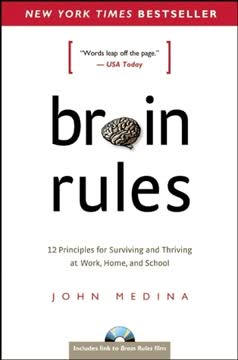つの重要なポイント
1. 運動は脳力と認知機能を向上させる
運動する人は、長期記憶、推論、注意力、問題解決能力において、座りがちな人よりも優れている。
身体活動は脳機能を向上させる。 定期的な運動は脳への血流を増加させ、酸素と栄養素をより多く供給する。これにより、新しいニューロンの生成が促進され、特に記憶と学習に重要な海馬において既存の神経接続が強化される。
運動は認知能力を向上させる。 研究によれば、身体的に活動的な人々は様々な精神的タスクにおいて優れた成績を収める:
- 記憶保持の向上
- 問題解決能力の向上
- 注意力の増加
- 実行機能の向上
長期的な利益は大きい。 生涯にわたる一貫した身体活動は:
- 認知機能の低下リスクを最大60%減少させる
- アルツハイマー病の発症リスクを低減させる
- 全体的な脳の健康と精神的な幸福を向上させる
2. 人間の脳は変化する環境に適応するよう進化した
私たちの脳は1日に12マイル歩くために作られた!
環境の変化が脳を形作った。 祖先が森林からサバンナに移動するにつれて、新たな挑戦に直面し、認知的適応が必要となった。これにより、問題解決や抽象的思考が可能な、より大きく複雑な脳が発達した。
適応力が生存の鍵となった。 人間の脳は以下のように進化した:
- 急速に変化する状況に対応する
- 経験から学び、新しい状況に知識を応用する
- グループ協力とコミュニケーションのための社会的スキルを発展させる
これらの適応により、人類は多様な環境で繁栄し、最終的に地球上で支配的な種となった。
3. すべての脳は異なる配線を持ち、学習と知能に影響を与える
2人の人間の脳が同じ情報を同じ方法で同じ場所に保存することはない。
脳の構造は個々に異なる。 神経接続は遺伝、経験、環境によって個々に独自のパターンを形成する。この多様性が、人々が情報を学び処理する方法の違いを説明する。
複数の知能のタイプが存在する。 ハワード・ガードナーの多重知能理論は、認知能力が従来のIQ測定を超えて広がることを示唆している:
- 言語的知能
- 論理数学的知能
- 空間的知能
- 音楽的知能
- 身体運動的知能
- 対人的知能
- 内省的知能
- 自然主義的知能
これらの多様な知能を認識し育むことで、より効果的な学習と問題解決の戦略が生まれる。
4. 注意力は選択的であり、退屈によって容易に妨げられる
私たちは退屈なものに注意を払わない。
脳は情報を選択的にフィルタリングする。 私たちの注意システムは、新しい、重要な、または感情的に充実した刺激に焦点を当て、無関係な情報を無視するように進化した。この選択的プロセスは、複雑な環境を効率的にナビゲートするのに役立つ。
退屈は学習とパフォーマンスを妨げる。 脳が情報を面白くないまたは無関係と認識すると、集中力を維持するのが難しくなる。これを防ぐために:
- 情報を感情的に共鳴する方法で提示する
- 興味を維持するために多感覚入力を使用する
- コンテンツを短いセグメントに分ける(10分ルール)
- 注意を引くために新奇性と驚きを取り入れる
注意力の仕組みを理解することで、教育者やコミュニケーターはより効果的な学習体験を設計できる。
5. 繰り返しは記憶の形成と保持に不可欠である
覚えるために繰り返す。
記憶の定着には繰り返しが必要である。 脳は情報に繰り返し触れることで神経接続を強化する。このプロセスは短期記憶を長期で安定した記憶に変える。
間隔を空けた繰り返しは保持力を高める。 時間をかけて情報を復習することは、一度に詰め込むよりも効果的である:
- 学習後数時間以内に最初の復習
- 翌日以内に2回目の復習
- その後、徐々に間隔を広げて復習(数日、数週間、数ヶ月)
精緻化リハーサルは想起を改善する。 情報に意味のある方法で関与すること、例えば:
- 新しい情報を既存の知識に結びつける
- 材料を他人に説明したり教えたりする
- 概念を実世界の状況に適用する
これらの戦略は、より強力でアクセスしやすい記憶を作り出すのに役立つ。
6. 睡眠は認知機能と記憶の定着に不可欠である
よく眠れば、よく考えられる。
睡眠不足は認知パフォーマンスを低下させる。 睡眠不足は以下に影響を与える:
- 注意力と集中力
- 意思決定能力
- 感情の調整
- 記憶の形成と想起
睡眠は記憶の定着に重要な役割を果たす。 睡眠中、脳は:
- 一日の情報を処理し整理する
- 重要な記憶のための神経接続を強化する
- あまり重要でない情報を剪定する
十分な睡眠は学習と問題解決を向上させる。 研究によれば:
- 学習前の良質な睡眠は情報の取得を向上させる
- 学習後の睡眠は記憶の保持を改善する
- 昼寝は認知パフォーマンスと創造性を向上させる
認知機能を最適化するためには、一貫した質の高い睡眠を優先することが重要である。
7. 慢性的なストレスは学習と脳の健康を損なう
ストレスを受けた脳は同じように学習しない。
慢性的なストレスは脳機能に悪影響を与える。 ストレスホルモンへの長期的な曝露は:
- 海馬を縮小させ、記憶と学習を損なう
- 扁桃体を拡大させ、感情的反応性を増加させる
- 前頭前皮質の機能を低下させ、意思決定と衝動制御に影響を与える
ストレス管理は最適な学習に不可欠である。 ストレスを軽減するための技術には以下が含まれる:
- 定期的な運動
- マインドフルネスと瞑想の実践
- 十分な睡眠と栄養
- 社会的支援とつながり
ストレスを効果的に管理することで、脳の健康を保護し、認知パフォーマンスを向上させることができる。
8. 多感覚体験は学習と記憶を強化する
同時により多くの感覚を刺激する。
脳は複数の感覚から情報を統合する。 学習体験が同時に複数の感覚を引きつけると、脳はより強力で包括的な記憶を形成する。
多感覚学習は保持力と想起を向上させる。 研究によれば:
- 複数の感覚チャネルを通じて提示された情報は、単一の感覚入力よりもよく記憶される
- 視覚情報と聴覚情報を組み合わせると理解が向上する
- 触覚や運動感覚の要素を追加すると学習がさらに強化される
多感覚学習の実践的応用:
- 口頭説明を補完するために視覚的補助を使用する
- 実践的な活動やデモンストレーションを取り入れる
- 学習者をディスカッションやロールプレイングに参加させる
- テクノロジーを活用して没入型の多感覚体験を作り出す
複数の感覚を刺激することで、教育者やコミュニケーターはより効果的で記憶に残る学習体験を提供できる。
9. 視覚は感覚知覚と情報処理を支配する
視覚は他のすべての感覚を凌駕する。
視覚処理は脳のリソースの大部分を占める。 脳は他のどの感覚よりも視覚に多くの神経領域を割り当てており、その進化的な重要性を反映している。
視覚情報は他の感覚入力よりも効率的に処理される。 脳は:
- テキストよりも画像を速く認識する
- 言葉よりも絵を覚えやすい
- 複雑な視覚シーンをミリ秒単位で処理する
視覚的コミュニケーションを活用すると理解と保持が向上する:
- データを提示するためにグラフ、チャート、インフォグラフィックを使用する
- プレゼンテーションに画像やビデオを取り入れる
- 抽象的な概念を説明するために視覚的メタファーを作成する
- 視覚的ストーリーテリング技術を活用する
コミュニケーションや学習資料に視覚的要素を優先することで、脳の自然な強みを活用できる。
10. 男性と女性の脳には構造的および機能的な違いがある
男性と女性の脳は異なる。
遺伝的およびホルモン的要因が脳の発達に影響を与える。 XおよびY染色体と性ホルモンは、男性と女性の脳の構造的および機能的な違いに寄与する。
主な違いには以下が含まれる:
- 脳のサイズと構造(例:女性の方が大きい脳梁)
- 神経伝達物質の生成と調整
- 感情処理とストレス反応
- 言語処理と空間推論
学習と行動への影響:
- 異なる問題解決戦略
- 感情表現と調整の違い
- リスクテイクと意思決定の潜在的な違い
これらの違いを理解することで、より効果的な教育および職場戦略を策定できるが、個人差が性別による違いを上回ることが多いことを認識することが重要である。
11. 人間は生まれつき探求者であり、幼少期から好奇心に駆られている
私たちは強力で自然な探求者である。
好奇心は基本的な人間の特性である。 幼少期から、人間は環境を探求し理解しようとする生まれつきの動機を示す。この探求行動は認知発達と学習に不可欠である。
赤ちゃんは自然の科学者である。 乳児は世界について学ぶために体系的な探求と実験を行う:
- 対象の永続性をテストする
- 因果関係を探求する
- 他者を模倣し学ぶ
生涯学習は私たちの探求的な性質に根ざしている。 この生まれつきの好奇心を生涯にわたって奨励し育むことで:
- 問題解決能力を向上させる
- 創造性とイノベーションを促進する
- 変化する環境への適応力を高める
私たちの自然な探求傾向を認識しサポートすることで、すべての年齢層に対してより魅力的で効果的な学習環境を作り出すことができる。
最終更新日:
FAQ
What's Brain Rules about?
- Understanding brain function: Brain Rules by John Medina explores how the brain works and how this knowledge can be applied to improve learning and productivity in various environments, such as work and school.
- 12 principles: The book outlines 12 key principles, or "Brain Rules," that explain how factors like exercise, sleep, and stress affect brain function and learning.
- Real-world applications: Each rule is supported by scientific research and includes practical ideas for applying these principles in everyday life to enhance cognitive performance.
Why should I read Brain Rules?
- Enhance learning: Reading Brain Rules can help you understand how to optimize your learning and memory retention by applying the principles of brain science.
- Improve productivity: The insights provided can lead to better productivity at work and more effective teaching methods in educational settings.
- Engaging writing: Medina presents complex scientific concepts in an accessible and engaging manner, making it enjoyable for readers of all backgrounds.
What are the key takeaways of Brain Rules?
- Exercise boosts brain power: Regular physical activity enhances cognitive functions such as memory, attention, and problem-solving skills.
- Sleep is crucial: Quality sleep is essential for effective thinking and memory consolidation, impacting overall cognitive performance.
- Attention matters: Engaging and emotionally relevant content captures attention better than boring material, leading to improved learning outcomes.
What are the best quotes from Brain Rules and what do they mean?
- "Exercise boosts brain power." This emphasizes the strong link between physical activity and cognitive function, suggesting that incorporating exercise into daily routines can enhance mental performance.
- "We don’t pay attention to boring things." This highlights the importance of engaging content in learning environments, indicating that emotional and interesting material is more likely to be remembered.
- "Sleep well, think well." This underscores the critical role of sleep in cognitive processes, suggesting that adequate rest is necessary for optimal brain function.
What is the first rule in Brain Rules?
- Exercise boosts brain power: The first rule states that physical activity significantly enhances brain function, improving memory, attention, and problem-solving abilities.
- Evolutionary perspective: Medina explains that our brains evolved while we were physically active, and they still crave movement, making exercise essential for cognitive health.
- Practical implications: Integrating exercise into daily routines, whether at work or school, can lead to better cognitive performance and overall well-being.
How does stress affect learning according to Brain Rules?
- Stressed brains don’t learn the same way: Stress can impair cognitive functions, making it harder to learn and retain information.
- Biological response: The book discusses how stress triggers a fight-or-flight response, which can hinder the brain's ability to process and store new information.
- Managing stress: Medina suggests that creating low-stress environments can enhance learning and productivity, emphasizing the need for emotional safety in educational and work settings.
What does Medina say about memory in Brain Rules?
- Memory is complex: Medina explains that memory involves multiple systems, including short-term and long-term memory, each with distinct processes.
- Importance of repetition: The book emphasizes that repetition is crucial for transferring information from short-term to long-term memory, highlighting the need for spaced learning.
- Memory retrieval: Medina discusses how memories can be reconstructed over time, which can lead to inaccuracies, underscoring the importance of context in memory recall.
How does Brain Rules address the concept of attention?
- Attention is selective: The book explains that the brain can only focus on one thing at a time, making multitasking a myth.
- Engagement is key: Medina emphasizes that emotionally engaging content captures attention better than dull material, which is critical for effective learning.
- Attention spans: The book suggests that attention typically wanes after about 10 minutes, advocating for breaks and varied content to maintain engagement.
What is the significance of sleep according to Brain Rules?
- Sleep is essential for memory: Medina argues that sleep plays a vital role in consolidating memories and enhancing cognitive function.
- Effects of sleep deprivation: The book discusses how lack of sleep can lead to cognitive decline, affecting attention, problem-solving, and overall mental agility.
- Recommendations for sleep: Medina encourages prioritizing sleep as part of a healthy lifestyle to support optimal brain function and learning.
How does Brain Rules suggest we can improve our learning environments?
- Create engaging content: Medina advises that learning materials should be interesting and emotionally relevant to capture attention and enhance retention.
- Incorporate movement: The book suggests integrating physical activity into learning environments, such as schools and workplaces, to boost cognitive performance.
- Personalize learning: Medina emphasizes the importance of tailoring educational approaches to individual learning styles and needs, recognizing that every brain is wired differently.
What does Medina say about sensory integration in Brain Rules?
- Multisensory learning benefits: The principle "Stimulate more of the senses" emphasizes that engaging multiple senses during learning enhances retention and understanding of information.
- Real-world applications: Medina encourages educators and professionals to incorporate multisensory approaches in teaching and presentations to improve engagement and effectiveness.
- Cognitive processing: The brain processes sensory information in a way that allows for better integration and understanding, leading to improved learning outcomes.
What role does curiosity play in learning according to Brain Rules?
- Natural explorers: Medina posits that humans are inherently curious and that this drive for exploration is fundamental to learning and discovery.
- Lifelong learning: Fostering curiosity can lead to a lifelong pursuit of knowledge, encouraging individuals to seek out new experiences and information throughout their lives.
- Encouraging exploration: The book suggests that educational and work environments should nurture this curiosity to enhance engagement and motivation in learning.
レビュー
本書『Brain Rules』は、主に好意的な評価を受けており、読者はその魅力的な文体と脳科学のわかりやすい説明を称賛している。多くの人々は、認知機能を向上させるための実践的な応用と「ルール」が役立つと感じている。一部の批評家は、内容が簡略化されすぎている、または特定の分野で深みが欠けていると指摘している。読者は、著者が概念を説明するために用いる逸話や例を評価しているが、少数の人々はこのアプローチが繰り返しに感じることもある。全体として、本書は脳の機能を理解し、神経科学を日常生活に応用したいと考える人々に推奨されている。
Similar Books
















